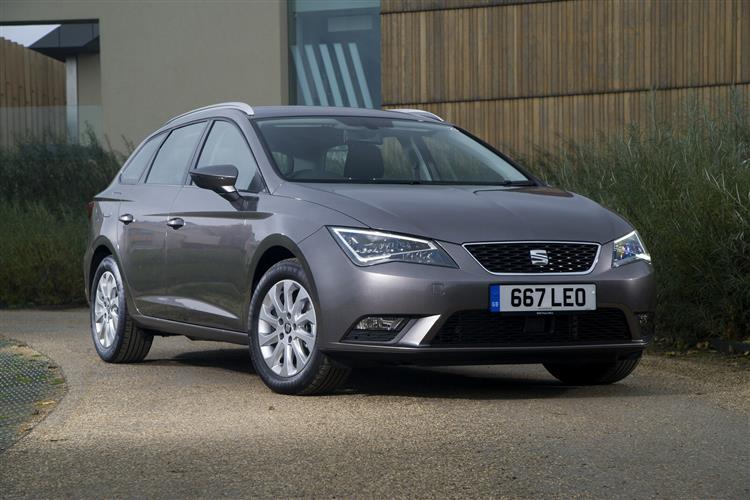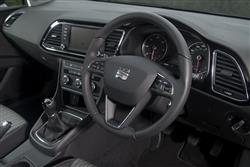SPANISH TRY (some text hidden) --NONE--
By Jonathan Crouch
Introductionword count: 83
The third generation SEAT Leon was the first to be made available as an estate, this station wagon model badged 'ST' and sold in 'Type 5F'-series guise between 2013 and 2020. With all the hi-tech design excellence of the Golf Estate it was based upon but much more affordable pricing and an arguably sportier look and feel, it's exactly the kind of car the Spanish brand needed during the 2013-20 period in this sector. But does it make sense as a used buy?
Modelsword count: 10
5dr Estate (1.0,1.2,1.4,1.5, 2.0 TSI, / 1.6 & 2.0 TDI)
Historyword count: 204
So to the SEAT Leon ST, a compact estate that in this 'Typ 5F'-series form sold between 2013 and 2020 wasn't that compact. It's a sensible station wagon that claims to be sporty. A car of contradictions then, but one that promises to be quite appealing family transport. Back in 2013, this was the first time the Leon range had included an estate derivative, though SEAT had sold in this segment before with their Exeo ST model. That car though, was a rather half-hearted effort based on out-dated Audi A4 Avant underpinnings. This one was very different, launched in the UK early in 2014 and running on the same hi-tech MQB platform that underpinned the 7th generation Volkswagen Golf. Golf and Leon models shared most of the same engines too. This was, in short, a very thoroughly engineered product. Practical and sporty, it aimed to offer a more dynamic option to compact estate buyers, with a 'lifestyle' appeal that set out to also pique the interest of folk looking at Qashqai-class crossovers. The range was significantly facelifted in 2017 and the Leon ST in this form sold until Spring 2020, when it was replaced by an estate derivative of the all-new MK4 Leon model.
What You Getword count: 1062
This was one of the more dynamic shapes in the compact estate segment from the 2013-2020 period. To create it, the Spanish designers had to compromise a little on ultimate carriage capacity: without the smartly angled rear screen for example, you could certainly fit a bit more in, but then the car would look a little more boxy and boring. To start with, let's cover the basics. Which are that this ST rides on exactly the same wheelbase as its five-door hatchback stablemate but carries an extra 270mm of length behind the rear axle to accommodate its larger luggage compartment. The beady-eyed front end of course, is identical to that of any other Leon, a set of angular Audi-style headlamps with optional LED illumination sitting either side of the usual trapezoidal SEAT grille. It's a decisive, sharply drawn shape with a clean, crisp, racy look emphasised by the characteristic SEAT 'Linea Dinamica' profile line that runs rearwards over the arches. And it's also a clever piece of design as well as a good looking one, the angular panel work draped over SEAT's version of the Volkswagen Group's MQB modular transverse platform. On to the practicalities that estate buyers will prioritise. The loading height isn't particularly low and accessible, but that same comment applies to rival models that, like this car, have to comply with rear accident safety legislation. Raise the sloping tailgate though and you'll find a 587-litre boot that's a usefully square shape and fully 55% bigger than that of the hatchback model, though is 18 and 23-litres respectively smaller than the boots you'll find in estate versions of the Skoda Octavia and Volkswagen Golf from this period: we don't think that's a large enough difference to matter too much to most family owners though, particularly as the space available in this SEAT is a very practical one, with bag hooks, a 12v power socket, a ski-hatch for longer items and tie-down points for an optional luggage net that'll keep your shopping in place should you get a bit carried away with your ST's sporty handling. At the bottom of the floor area, space for the optional spare wheel is carpeted, creating a deep storage area where that'll be useful for storing small, loose items. It's a pity that the tonneau cover can't be tilted upwards to ease loading, but we do like the way that it can be stored out of the way under the boot floor when not in use. And talking of the boot floor, it's one of those neat split-level ones, so you can reposition the cargo base to suit the load you're carrying. Put it in its highest position and you can create an almost completely flat load area when you push forward the split-folding rear bench, a process that's much easier if you've avoided one of the base-trimmed models that do without the 'Easy rear seat-back release' system. With this, the seatbacks are spring-loaded and automatically drop down when you pull on neat handles on the side of the cargo bay. Once the 60/40-split backrest has fallen flat, carriage capacity rises to 1,470-litres. Of course, even that may not be enough for really long items and if you're likely to be regularly carrying that sort of thing, then you'll need to get yourself a Leon ST whose original owner ticked the box for the optional fold-flat front passenger seat. This means you can carry items up to 2.5m in length - say an extra-long step-ladder. Unfortunately, these extra-long items can't be too wide as the narrower (rather than the broader) section of the split backrest is the one directly behind the fold-flat front passenger seat. Now let's talk people rather than packages and discuss the back seat. One of SEAT's claims for this car - broadly borne out by the figures - is that it offers as much practicality as a larger estate from the next medium range segment up where you'd find station wagon versions of cars like Ford's Mondeo and Vauxhall's Insignia. That's something you certainly feel on the back seat of a Leon ST where, thanks to this SEAT's generous wheelbase dimensions, there's just as much head and legroom as you'd find in a more expensive car of that kind. True, the width of this cabin isn't as generous as it would be in a Mondeo, so three adults will need to be on friendly terms - but then that applies to all this SEAT's other most direct rivals. We should say though, that space for your head is a little more generous than it would be in a standard Leon hatchback, thanks to this estate model's longer roofline. The light colouring for the headlining helps the airy spacious feel, something original buyers could further enhance by opting for the huge panoramic glass sunroof specially developed for this ST body style. And up front? Well get behind the wheel and the only clue that you're at the wheel of an estate car is that the back screen is a touch further away from the rear view mirror. Otherwise, it's just as impressive a cabin environment as you'll find in any other third generation Leon model. There are charismatic touches like the unusual trapezoidal shapes for things like the door handles and the air vents. And you don't have to put up with arguably pointless features like push button starters and electronic handbrakes. We also prefer this car's higher placement of the infotainment touchscreen - or as SEAT likes to call it, the EASYCONNECT operating system - dominating the centre part of the dashboard and far more in your line of sight than it is in, say, a Golf. It's there to reduce button clutter by dealing with stereo, on board computer, phone, navigation, parking and, if specified, Drive Profile system functions, all operated via a screen that comes in two sizes, with carousel-style graphics also replicated on the additional display you'll find in the centre of the instrument cluster. This is a practical place to be too. The big glovebox is one of thirteen cubby holes dotted around the car, plus there are five closed cubbies in the doors and centre console as well as below and between the front seats. This is, after all, a family car first and foremost and should be equipped to swallow the paraphernalia of everyday life.
To see the full road test text contact us on 0330 0020 227
Pictures (high res disabled)

.jpg)
|
.jpg)
|
.jpg)
| |||
.jpg)
|
.jpg)
|
.jpg)
| |||

|



